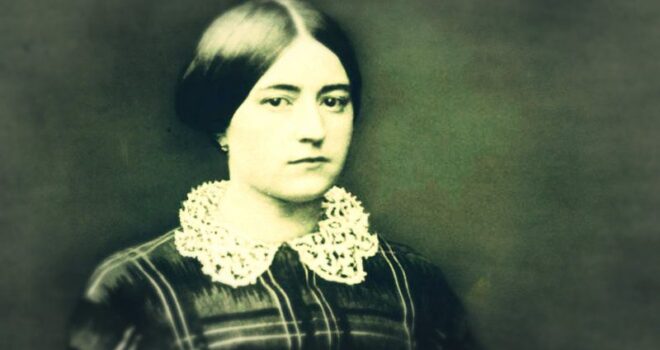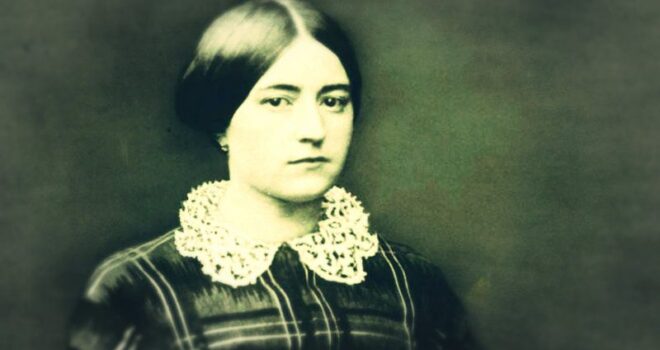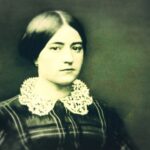Azélie-Marie Guérin was born two days before Christmas in 1831 near the small town of Saint-Denis-sur-Sarthon, France. Zélie, as she was known, from an early age aspired to be a nun, but was turned away by the Sisters of Charity of Saint Vincent de Paul due to her respiratory difficulties and recurrent headaches. She then prayed that God might send her many children and they would be consecrated to Him. In the meantime, she became a lacemaker manufacturing Alençon lace.
On the Bridge of St. Leonard, one fine spring day in 1858, Zélie passed a distinguished, but reserved, hardworking watchmaker. For Louis Martin, like the occasion when Dante first laid eyes on Beatrice on the Rialto Bridge, it was love at first sight. It was a most providential rendezvous. Zélie heard an interior voice, one she had learned to trust say to her, “This is he whom I have prepared for you.” Three months later, they were married on July 13. Louis had wanted to be a monk, but was turned down because he did not know Latin. From all indications, their meeting paved the way for a match made in heaven.
Their life together as husband and wife began on July 12, 1858, a date established by the Church as the feast day of the first husband and wife to be canonized as a couple. For the first 10 months of living together, they were celibate. They decided to consummate their marriage on the advice of their spiritual director.
Their life together was a model of holiness. They attended 5:30 AM Mass every morning and received communion as much as the custom allowed. They never worked on Sundays, were very generous with their time and money towards the poor, sought to perform works of mercy, and went out of their way to help people who were dying to receive the last rites. Their home was an ecclesia, a little church in itself.
If a prophet had told Zélie that she would become a famous lacemaker, marry the man whom God had sent her, give birth to five daughters who would enter into the religious life, of whom one would be declared a saint and Doctor of the Church, and another would have her cause for beatification officially opened, she would most probably have fainted on the spot, but with joy. And yet, that is exactly what happened.
But her life was not one of uninterrupted joy. Four of the nine children she bore, two boys and two girls died in infancy (Hélène died at age 5). “When I closed the eyes of my dear little children and buried them,” she lamented, “I felt sorrow through and through.” When people told her that it would have been better had they never been born, she confessed that she “couldn’t stand such language.” “My children were not lost forever; life is short and full of miseries, and we shall find our little ones again up above.” In 1865 a gland in her right breast, which degenerated into cancer, caused her great suffering. Her condition worsened until it claimed her life in 1877. She was 45 years of age when she passed into the next world, leaving behind her husband and five daughters. Her youngest child, Thérèse, was only four young at that time. After her death, Pauline, Marie, Thérèse, and Céline entered Carmel and Léonie became a Visitation Sister.
Zéile went to Lourdes seeking a cure. “If the Good Lord wants to heal me, I will be very happy, because deep down, I want to live; it costs me to leave my husband and my children. But on the other hand, I say to myself: if I do not get well, it is because it will perhaps be more useful for them to go away.” Her life alternated between extreme joy and extreme sorrow, but her faith in God was ever constant.
Reflecting on her children, Zélie said that “we lived only for them; they made all our happiness and we would never have found it save in them. In fact, nothing any longer cost us anything; the world was no longer a burden to us. As for me, my children were my great compensation, so that I wished to have many in order to bring them up for Heaven.” In looking back at her mother’s life, Céline made the following reflection, “In a word, always active, always devoted, constantly smiling, our mother never appeared to be doing anything extraordinary, but with remarkable simplicity and humility, she tirelessly spent herself for others, and lived always for the good of God.”
Zélie’s name is derived from the Azalea flower. It is interesting to note that her most celebrated daughter is known as the “Little Flower.” The flower symbolizes both beauty and fragility. It applies very well to both Zélie and Thérèse.
On March 26, 1994, John Paul II proclaimed the heroic virtues of Zélie and Louis Martin and declared them Venerable. On June 27, 2015, during the public Consistory, Pope Francis announced the date of the canonization of this holy couple. The canonization took place on Sunday October 18, 2015 in Rome. Two miracles had been confirmed, as a result of their intercession, one in Valencia, the other in Milan. Saints Zélie and Louis Martin are patron saints of illness, marriage, parenting, and widowers.












